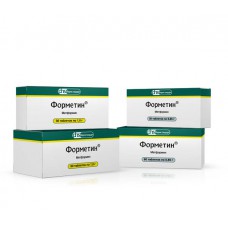Expiration date: 08/2026
The composition and form of issue:
Tablets. 1 tablet contains active substance:
Metformin hydrochloride 500, 850 or 1000 mg
auxiliary substances: povidone of medium molecular (PVP) croscarmellose sodium magnesium stearate for pharmaceutical industry
in packages contour cell 10 PCs. in cardboard pack of 3, 6 or 10 contour cell packs.
Description pharmaceutical form:
Tablets 500 and 850 mg: round biconvex shaped, white.
Tablets 1000 mg: oval biconvex, white, scored on both sides.
Pharmacokinetics:
After intake of Metformin is slowly absorbed from the gastrointestinal tract. The bioavailability after administration of a standard dose of 50-60%. Cmax in plasma achieved through 2.5 h after ingestion. There is not associated with plasma proteins. Accumulates in the salivary glands, muscles, liver and kidneys. Excreted unchanged by the kidneys. T1/2 is 1.5–4.5 h in the human kidney possible accumulation of the drug.
Description pharmacological action:
Metformin inhibits hepatic gluconeogenesis, reduces glucose absorption from the intestines, enhances peripheral glucose utilization and increases the sensitivity of tissues to insulin. When this has no effect on insulin secretion &beta-cells of the pancreas, does not cause hypoglycemic reactions. Reduces the level of triglycerides and cholesterol in the blood. Stabilizes or reduces body weight. Provides fibrinoliticescoe effects by suppressing the inhibitor of plasminogen activator of tissue type.
Indications:
- Diabetes mellitus type 2 with poor diet (especially in patients who are obese).
Contraindications:
- diabetic ketoacidosis, diabetic precoma, coma
- expressed violations of kidney function
- cardiac and respiratory failure, the acute phase of myocardial infarction, acute violation of cerebral circulation, dehydration, chronic alcoholism and other conditions that can contribute to the development of lactic acidosis
- pregnancy and breastfeeding
- hypersensitivity to the drug
- major surgery or trauma, when shown holding insulin therapy
- severe infectious diseases
- the liver
- acute alcohol poisoning
- lactic acidosis (including history)
- application for at least 2 days before and 2 days after the radioisotope or radiological examinations with administration of iodinated contrast agents
- adherence to a reduced-calorie diet (<1000 cal/day).
Caution: do not use this drug in people over 60 years, performing heavy physical work, in connection with an increased risk of development of lactic acidosis.
Side effects:
On the part of the digestive system: nausea, vomiting, metallic taste in the mouth, lack of appetite, diarrhea, flatulence, abdominal pain.
From the metabolic: in rare cases, lactic acidosis (requires stopping treatment) long-term treatment — hypovitaminosis B12 (malabsorption).
The bodies of the blood: in some cases, megaloblastic anemia.
From the endocrine system: hypoglycemia (when used in inadequate doses).
Allergic reactions: skin rash.
Drug interactions:
While the use of sulfonylureas, acarbose, insulin, NSAIDs, inhibitors of MAO, oxytetracycline, ACE inhibitors, derivatives of clofibrate, cyclophosphamide, &beta-blockers may increase the hypoglycemic action of Metformin.
While the use of corticosteroids, oral contraceptives, epinephrine, sympathomimetics, glucagon, thyroid hormones, thiazide and loop diuretics, phenothiazine derivatives, derivatives of nicotinic acid may reduce hypoglycemic action of Metformin.
Zimetidin slows down metformina, thereby increasing the risk of lactic acidosis.
Metformin may weaken the effect of anticoagulants (coumarin derivatives).
While concurrent use of alcohol may develop lactic acidosis.
Nifedipine increases the absorption, Cmax and slows the excretion of Metformin.
Cationic drugs (amiloride, digoxin, morphine, procainamide, quinidine, quinine, ranitidine, triamterene, vancomycin), secretiruetsa in the tubules and compete for canalave transport system and with long-term therapy may increase Cmax of the drug is 60%.
Method of application and dose:
Inside.
The dose is determined by physician individually, depending on the level of glucose in the blood.
Accept not liquid during or after eating, squeezed enough water. The initial dose is 500 mg 1-2 times per day or 850 mg of 1 times a day, gradually (1 time per week) the dose is increased to 2000-3000 mg per day. The maximum daily dose is 3000 mg.
In elderly patients the daily dose should not exceed 1,000 mg Because of increased risk of lactic acidosis, in severe metabolic disorders, the dose should be reduced.
Overdose:
Symptoms: may develop lactic acidosis with a fatal outcome. The reason for the development of lactic acidosis could also be the accumulation of the drug due to renal dysfunction. Early symptoms of lactic acidosis are weakness, nausea, vomiting, diarrhea, low body temperature, abdominal pain, muscle pain, decrease in blood pressure, reflex bradiaritmia, in the future there may be shortness of breath, dizziness, violation of consciousness and coma.
Treatment: if symptoms of lactic acidosis, treatment with Metformin must be stopped immediately, the patient should be hospitalized immediately, determine the concentration of lactate, to confirm the diagnosis. The most effective measure for removal from the body lactate and Metformin is hemodialysis. Spend as symptomatic treatment.
Precautions:
During treatment should monitor kidney function. At least 2 times a year, and when myalgia should determine the content of lactate in plasma.
The drug use Formatin in combination with sulfonylureas. In this case, a particularly careful monitoring of glucose levels in the blood.
Effects on ability to drive or to perform work requiring high speed physical and mental reactions. When used in monotherapy Formetin does not affect the ability to drive vehicles and operate machinery.
The combination of the drug Formation with other hypoglycemic agents (including sulfonylureas, insulin) perhaps the development of hypoglycemic conditions, which impair the ability to drive vehicles and occupation of other potentially hazardous activities, require increased attention and rapid psychomotor reactions.


